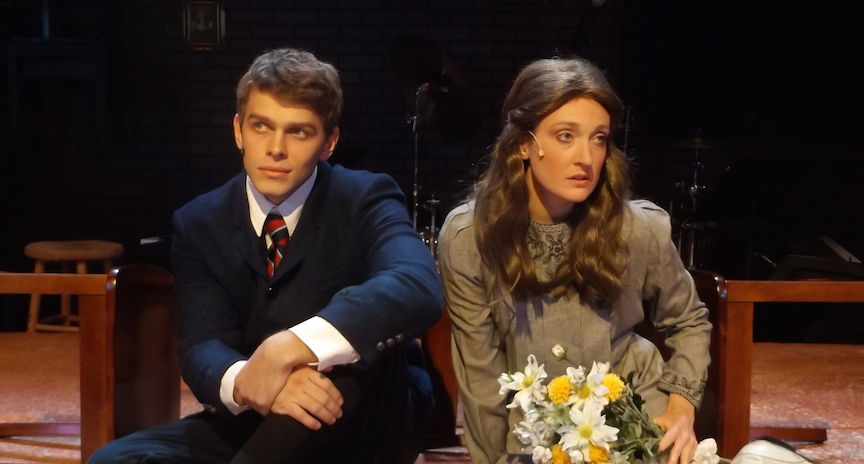Composer Johannes Brahms
Brahms Ein Deutsches Requiem
Louisville Chorus and Louisville Philharmonia
Daniel Spurlock, conductor
Alexander Redden, Mary Wilson Redden & Darlene Welch, soloists:
Review by Annette Skaggs
Entire contents copyright © 2014 by Annette Skaggs. All rights reserved.
I have been a fan of the Louisville Chorus under the baton of Daniel Spurlock for a very long time and was excited to read that they would be performing Brahms’ Requiem Mass, Op. 45 along with Mahler’s Das himmilische Leben, the 4th movement of his Symphony No. 4 and Dvořák’s “Song to the Moon” from Rusalka.
Admittedly, I have only heard or performed excerpts of the Requiem in the past, so I was grateful to hear the piece in its entirety. But let’s start with Mahler and Dvořák.
There was a near capacity crowd at St. Boniface for this performance. From the opening verses of Das himmilische Leben (The Heavenly Life) we are gifted with listening to a child’s version of what life in Heaven would be like but make no mistake, this child (sang by soprano Darlene Welch) knows of the grand feasts and love that abounds in the Kingdom, but also talks of the slaughter of a lamb to provide for those banquets on high. Ms. Welch did a splendid job in portraying the soft tender moments as well as the pensive tone of sacrifice. However, often times Ms. Welch’s voice could not climb over the full sound of the orchestration, as lovely as it was.
“Song to the Moon” is a hauntingly beautiful aria sung by the opera’s title character Rusalka, a water fairy or goblin in some translations. Rusalka has fallen in love with a handsome prince and sings of her love of the prince to the moon, asking that it share with the prince the love that she has for him. I won’t go into the whole opera here, obviously, but I will let you know that Ms. Welch approached this aria with a lovely resonance and tone and the orchestration was equally entrancing, save for a few moments of brass and/or woodwinds overpowering the overall sound.
On to the main event, the Ein deutsches Requiem (A German Requiem) set in seven movements, full chorus and orchestra with soprano and baritone soloists. Unlike typical Latin Requiems, Brahms’ Ein deutsches Requiem is as the name implies, a German-language Requiem.
The first movement, Selig sind, die da Leid tragen (Blessed are they that mourn) allows the listener to be contemplative and reflect on the text, Matthew 5:4 and Psalm 126:5, 6. The only distraction from that contemplation was that there were a few cutoff issues with both the orchestra and chorus, but really nothing outside of a little nervousness and hardly noticeable.
Second movement, Denn alles Fleisch, es ist wie Gras (For all flesh, it is grass) with a tempo marked “Langsam, marschmäßig” (Slowly, march moderately) lends itself to a bit of a beat driven pace and the chorus and orchestra did a marvelous job of keeping up with Maestro Spurlock’s direction.
In the third movement, Herr, lehre doch mich (God, please teach me) we are introduced to bass Alexander Redden, who demonstrates a lovely top note baritone clarity. Since this piece is marked “Andante moderato” Brahms’ orchestration has a clear pulsing sound and the Philharmonia does a very nice job keeping with the moderate tempo.
Wie lieblich sind deine Wohnungen (How lovely are thy dwellings), the fourth movement, is set at a Mäßig bewegt (moderately moving) musical tempo and unlike the other movements, yes, the orchestration is beginning to set a quicker pace and it is noticeable in the singing of the chorus and the playing of the instrumentalists. It seemed that even more attention was given to the conductor and I am so glad that it was. In my opinion, of all of the movements, the fourth is my favorite because of the sheer melodiousness of the orchestra and choir together. One really can find a motif in this movement and hum it the rest of the day.
The fifth movement starts with Ihr habt nun Traurigkeit (You now have sadness) with the orchestration directive of Langsam (slow) and it most certainly is. It is in this setting we are introduced to Mary Redden who sings the texts of John 16:22 and Sirach 51:27. Ms. Redden’s top notes were the perfect counterpoint to the orchestra when more sound was needed, but unfortunately for me, I couldn’t hear her bottom notes too well over the full ensemble, but on the whole I very much enjoyed her voice and interpretation of the text in its expressiveness.
Andante (faster) is the pulse given for the penultimate movement Denn wir haben hie keine bleibende Statt (For here we have no resting place) and believe me when I tell you that every instrumentalist and every chorister took this directive to heart and task. Having been a member of many choirs myself I have gotten physically into the music that I have sang, even when I am supposed to be uniform and still. In this movement, with blasting trumpets and exhilarating pronouncements of good conquering evil and happiness prevailing, I smiled with glee watching the chorus and orchestra put heart, soul and bobbing heads and shoulders into their performance.
And as with many Latin Requiems, the last movement is given the directive Feierlich (Solemn) and the Louisville Chorus and Philharmonia did not disappoint on that instruction. With a strong middle voice section and adequate reigning in of too much noise the seventh movement allowed for its purpose to be followed through in the reflection of Selig sind die Toten (Blessed are the dead).
I applaud the over 100 musicians that gave the audience an illuminating performance from the beautiful pulpit of St. Boniface yesterday. I hope to hear you perform that again soon.
Bravo Tutti.
Brahms Ein Deutsches Requiem
May 18, 2014
Louisville Chorus and Louisville Philharmonia
St. Boniface’s Catholic Church
Cardinal Boulevard
Louisville, KY 40202
Louisvillechorus.org





